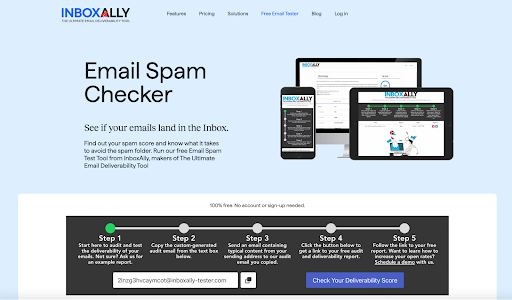![]()
Every day, cybercriminals send a whopping 3.4 billion emails pretending to be your trusted pals. We call it phishing. So, how do you avoid being one of their victims? By protecting your email. [1]
That’s where DMARC(Domain-based Message Authentication, Reporting and Conformance) comes in. It protects your emails against phishing attacks. It’s like a security guard for your emails.
But sometimes, things don’t go as planned, and we get DMARC failures. This article is here to help you understand why this happens and what you can do about it. Let’s dive in and make sense of DMARC failure together.
What are DMARC Failure Reports?
Think of DMARC failure reports as the watchdog notes for your emails. Imagine your emails have bodyguards, and these reports are messages from the bodyguards telling you if everything is secure or not.
When an email claims to be from someone, DMARC checks if it’s true. If everything matches, it’s a thumbs-up. But if something is off, like a fake signature, DMARC sends a report saying, “Hey, something fishy is going on!”
A DMARC failure report is your secret weapon to keep bad emails out. They show you where the trouble is, helping you fix it. It’s like having a personal assistant telling you, “Boss, we found a problem; let’s fix it together.”
Paying attention to these reports helps keep your emails safe from sneaky cyber criminals on the internet.
12 Causes of DMARC Failure
1. DKIM and SPF Authentication Failure
When it comes to DMARC failure, a common culprit is the breakdown in SPF and DKIM authentication. These are like your email ID cards. If they don’t match up or go missing, DMARC might get confused.
Imagine your emails are like letters with special stamps (DKIM) and return addresses (SPF). If these stamps or addresses are wrong, DMARC raises its eyebrows.
2. Lack of DNS Records
Think of DNS records as the address book for DMARC. Without them, DMARC can’t find the right addresses to verify your emails. It’s like sending a letter without a clear destination.
Proper DNS records, including SPF and DKIM, act like GPS for DMARC, ensuring your emails reach the right place. Lack of DNS records causes your emails to fail DMARC authentication.
3. DMARC Alignment Failures
DMARC loves it when things line up. Alignment failures happen when the “from” address in your email doesn’t match up with the signatures (DKIM and SPF).
It’s like getting a letter from a friend, but the handwriting doesn’t match theirs. DMARC sees this misalignment and raises a flag.
4. Unrecognized Sending Sources
DMARC is cautious about unfamiliar faces. If an email comes from a source not defined in your DMARC policy, it might raise concerns. Picture DMARC as your vigilant gatekeeper, only allowing in recognized guests.
5. Inconsistent Policy Enforcement
Consistency is key for DMARC. If your policies aren’t enforced uniformly, DMARC may get confused. It’s like having different rules for different sections of a library – chaos! DMARC wants every section to follow the same rules to keep things in order.
6. Subdomain Misconfigurations
Subdomains are like different sections in a mall, and DMARC wants them well-organized. Misconfigurations create confusion, making it tough for DMARC to keep track.
Imagine walking into a mall and the signs lead you to the wrong stores; that’s the chaos subdomain misconfigurations can cause.
7. Email Forwarding Challenges
Email forwarding can be a puzzle for DMARC. It’s like passing a letter through multiple hands. DMARC wants to ensure the letter reaches its final destination without being tampered with. Forwarding challenges can create hiccups in this process.
Combining DMARC with an email deliverability tool like Inboxally is highly beneficial for optimizing email performance.
Yes, yes, I know. It sounds like we are blowing our own trumpet. But we do believe our product is pretty amazing, especially when combined with DMARC.
DMARC provides valuable insights into email authentication and potential issues, while Inboxally actively works to improve sender reputation through positive engagement.
8. Dynamic IP address usage
DMARC prefers stable routes, and dynamic IP addresses are like ever-changing roads. It’s comparable to navigating a city where streets change daily.
DMARC may find it challenging to keep pace with emails traveling on dynamic IP addresses, potentially leading to a DMARC fail.
Dynamic IP addresses, unlike fixed ones, constantly shift and alter, much like a city’s ever-evolving streets. In email authentication, this can pose a significant hurdle.
9. Delayed DNS Propagation
Delayed DNS propagation is like sending a letter to an address that takes ages to update. DMARC demands real-time updates to ensure prompt email delivery. Delayed propagation can impede DMARC’s ability to validate emails quickly.
In order to pass DMARC authentication, DMARC relies on swift updates to DNS records. When these updates are delayed, it’s similar to your letter being stuck in the postal system, causing potential disruptions in the email authentication process.
10. Overly Strict Policies
Being overly strict can backfire. DMARC might label legitimate mail as troublemakers if your policies are excessively stringent.
Consider DMARC policies as the rules in a classroom. If they’re too strict, even well-behaved students(legitimate mail) might be unfairly penalized.
Similarly, overly strict DMARC policies might lead to legitimate emails being treated as potential threats, causing authentication failures.
11. Incorrect Reporting Addresses
Reports serve as feedback for DMARC. If reporting addresses are incorrect, it’s similar to sending a complaint to the wrong department. DMARC may miss crucial messages, hindering its ability to improve email authentication.
Accurate reporting addresses are the designated channels for DMARC to communicate potential issues. An incorrect address is like an undeliverable letter. The valuable insights and data fail to reach their intended recipients.
12. Security Software Interference
Excessive security software interference creates chaos for DMARC. It’s like having two security teams with conflicting instructions.
DMARC compliance relies on a cohesive and cooperative security environment. Excessive interference can lead to miscommunications, where one “team” flags legitimate emails while the other considers them potential threats.
This misalignment hampers DMARC’s ability to accurately authenticate emails, potentially causing failures.
Related: Email Deliverability – All You Need to Know to Avoid the Spam Folder
12 Solutions to DMARC Failure
1. Thoroughly Audit SPF/DKIM Configurations
Make sure your email security team reviews how SPF and DKIM are set up to prevent DMARC record failure. These are like the guards at the entrance; any mistakes might allow unauthorized emails in, leading to DMARC fail error.
Regular checks guarantee these guards work well, creating a strong defense against email issues.
2. DNS Record Validation
Think of DNS records as a map guiding DMARC. Validate these records to guarantee accurate navigation.
Accurate DNS records, incorporating SPF and DKIM, act as reliable guides for DMARC, ensuring that emails find their intended destination without any deviations.
Without proper validation, DMARC encounters turbulence, jeopardizing its ability to authenticate emails effectively.
3. Consistent Domain Alignment
DMARC works best when your “from” address, SPF and DKIM signatures are consistently aligned. This alignment is crucial for successful DMARC authentication checks.
Picture it like a dance; any misalignment disrupts the rhythm. Consistent domain alignment ensures DMARC can smoothly authenticate emails, recognizing them as genuine and reducing the chance of failures.
4. Comprehensive Sender Source Coverage
DMARC operates cautiously with unfamiliar email sources. Expanding its coverage to encompass a comprehensive list of legitimate senders is similar to widening its circle of trust.
By recognizing and approving a broad spectrum of legitimate senders, DMARC reduces the chances of false positives, ensuring that all authentic emails are authenticated without any problems.
5. Enforce DMARC Policies Strictly
Enforcing DMARC policies strictly is like having a vigilant bouncer at the entrance of a club, allowing only authenticated and authorized guests inside. DMARC, your email security bouncer, sets clear rules on who gets past the inbox ropes.
Strict enforcement ensures that only legitimate emails, with proper authentication, make it through, just as the bouncer permits only authorized individuals into the club.
6. Subdomain Management
Subdomain management is like maintaining order in different company sections. It ensures smooth operation and coordination among various digital departments on a website.
Efficient subdomain management is crucial for a well-organized and secure email environment, similar to how effective management ensures harmony and productivity in different divisions of a company.
7. Address Email Forwarding Challenges
Email forwarding can be a puzzle for DMARC, like passing a baton in a relay race. DMARC aims to ensure forwarded emails reach their destination without changes.
Addressing email forwarding challenges involves setting up mechanisms so DMARC can authenticate forwarded emails smoothly, reducing authentication problems.
8. Static IP Address Usage
DMARC thrives on stability, and choosing static IP addresses over dynamic ones ensures a reliable and consistent route for email authentication.
Opting for stability in the form of static IP addresses enhances the overall performance of DMARC in authenticating emails accurately.
9. Timely DNS Propagation
Timely DNS updates are crucial for the prompt and accurate functioning of the DMARC. It relies on real-time updates to DNS records for swift email authentication.
Delayed updates can hinder DMARC’s ability to validate emails promptly, stressing the importance of timely updates for a smooth email authentication process.
10. Policy Adjustments
DMARC policies should strike a balance – not too lenient and not overly strict. Adjusting policies involves fine-tuning them to match the diverse nature of legitimate email sources.
Think of it like calibrating rules in a game to ensure fairness. By making necessary adjustments, DMARC enhances its ability to authenticate emails accurately, reducing the chances of problems in the process.
Related: DMARC vs. DKIM – How Do They Differ and Which One Do You Need?
11. Accurate Reporting Configurations
Setting up accurate reporting configurations serves as DMARC’s feedback mechanism, providing essential insights into email authentication. This ensures you’re DMARC compliant.
Like sending feedback to the right department, accurate reporting configurations ensure that vital information about email authentication reaches the designated channels.
12. Security Software Compatibility
DMARC thrives in a cooperative security environment, making compatibility with security software crucial. Ensure that DMARC aligns seamlessly with your existing security infrastructure to prevent failing DMARC errors.
Incompatibility can disrupt the smooth operation of DMARC in authenticating emails, potentially leading to authentication failures.
Aligning different security systems for DMARC’s smooth operation ensures a harmonious security environment, enhancing the overall effectiveness of DMARC in securing your email communication channels.
To Wrap It Up
Overcoming DMARC failure involves understanding its causes and applying effective solutions. Ensure your SPF and DKIM settings are correct, address alignment issues, and manage subdomains carefully.
Enforce consistent policies, tackle email forwarding challenges, and verify compatibility with your security software. Crucially, pay attention to mail-sending practices, avoiding pitfalls that could lead to authentication failures or messages ending up in spam folders.
By taking these steps, you enhance your email security, ensuring messages reach their intended recipients without encountering DMARC-related obstacles.
Frustrated by DMARC failures impacting your emails? InboxAlly is the game-changer you need; turn DMARC insights into inbox victories, guaranteeing your emails not only survive but thrive. Book your free live demo now.
Reference



